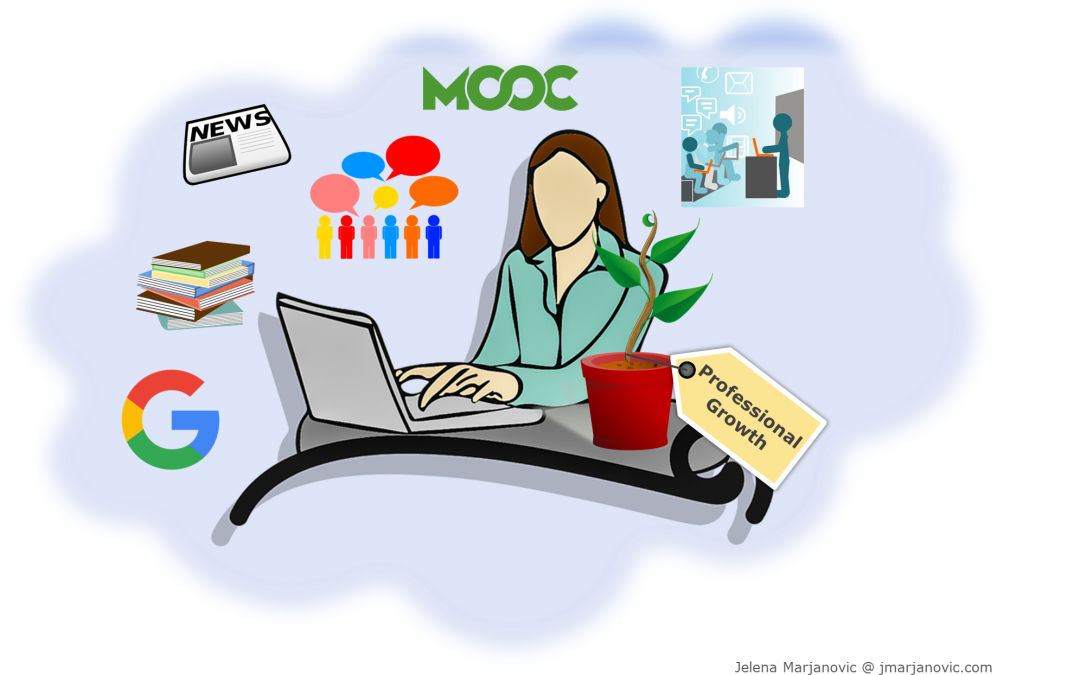Continuous professional development, despite how it name may sound, should be on literally everyone’s mind, be them employed, freelancer, unemployed, a stay-at-home person, a Queen, or person of any other status. Why? It is because anyone who does anything constructive should constantly learn and try to do it better. For example, in e-learning, which is a particularly fluid and rapidly growing field, professional development is in the foremost place a matter of staying in the field, and then competing against others.
There might be numerous professional development programmes organised by your employer or an external company, but you should not stop there. What you learn autonomously can mean much more for your development, especially with the help of widely-available technology. You must be thinking this is hardly news for you, as you already do take actions to stay up to date with the latest developments in your field, or try hard to learn new transversal skills that are bound to give you the desired edge over your competitors. Still, these individual actions will be of little effect unless they are performed as a part of a well-thought of and informed strategic approach to your own professional development.
The Autonomous Professional Development Micro Model
As I have experienced the same lack of organisation in my own professional development, I decided to create a model that would help me plan and organize my ‘extra-work’ learning activities, that is, actions I deliberately take outside of my normal work hours to grow professionally. In addition, I have drafted out a two-week day-by-day strategy plan to help me implement the model. The idea is to try it out for one month and share my reflections and feedback on it. More importantly, I have included a template for you to download and use for your own professional development.
The model is largely informed by the recent research on autonomous technology-enhanced learning and my own experience. What has to be emphasized is that the model does not include preparation steps such as identifying overall objectives, long and short term goals, and similar. These would make a macro model, whereas the one described here actually consists of concrete strategies that can be implemented daily in order to achieve the learning goals.

As you may see from my own professional development strategy plan, the ‘extra-work’ activities do not need to take too much of your time, especially if you take into account that your plan may be less intensive than the one you see here. Another option is to make these activities a part of your main work if you can (e.g. if you are self-employed) and thus give professional development top priority.
The 5 Strategies for Autonomous Professional Development
Get Information. This strategy refers to continuous learning. The key word here is continuous – it means you need to develop a habit of actively seeking for new information in your field and performing self-assessment to identify your knowledge gaps. There are many activities you can take to keep up to date with the latest trends and issues in your field of work, the most obvious one being reading. Lately, several articles such as this one from Business Insider have reported on reading habits of the most successful people in the world and as it turns out they all dedicate a lot of hours every day to this activity. In fact, for some of them you might rightfully wonder how they manage to fit their main work into the daily routine with so much reading going on (e.g. 6 hours a day in the case of Warren Buffet, or 6 books per week, which seems to be the routine of David Rubenstein). The bottom line is those who have achieved great success know just how much benefit reading gives you, and it seems like a good idea to follow suit.
However, reading just anything as long as you read is not a recommended strategy. In other words, you should be highly selective in what sources you consult and which topics you want to address for two reasons. Firstly, reliability and quality of writing limit the options to a handful of good sources, and secondly, even this handful of sources should be addressed selectively to avoid cognitive overload (getting in more information than you can actually effectively process). Therefore, an evaluation of the good-quality sources to determine which ones can be of most use to you is a must. For example, I have selected a few e-learning blogs, magazines and e-books that fulfill the following criteria: a) they are well-renowned, b) they cover exactly those topics I am interested in, and c) they are engaging and to the point. One important thing to add is that your selection of trusted sources should be constantly revised, especially considering the ever-increasing number of new publications. You might find yourself often replacing the old favourites with new ones, which is fine as long as you do not bite off more than you can chew.
Besides reading, there are many other ways to learn continuously. My plan includes attending webinars, but you may consider conferences, discussion forums and groups, online courses, and so on.
Reflect. Most scholars would agree that reflection is a crucial process in learning. When your mind engages with the new information, it helps retain it, relate it to other familiar constructs and come up with ideas for its real-life implementation. While probably most of us experience thoughts that accompany our reading/listening/watching, it does not automatically mean that we reflect effectively every time we engage in reception of information. What research has shown is that reflection facilitates learning best when expressed verbally, be it in writing or orally (see this study on online reflective conversations, for example). As a matter of fact, a great deal of courses aimed at enabling students to learn autonomously require them to regularly engage in reflection by keeping a learning journal, which is a convenient method to structure your thoughts and conclusions. This is an option I have chosen for my own professional development plan, as I appreciate the ability to assess my progress by reviewing older journal entries (something like visiting my older learner self), but you may find it more rewarding to express your reflections though chatting with other learners, recording audio notes, etc.
To read about the role of reflection in naturalistic language learning, see this post.
Share Information. When you receive information, process it and reflect on it, it is a good idea to share your conclusions with others because they can provide you with feedback that can help you better understand the matter, or show you a different perspective. These are all essential parts of any learning process and should thus be included in your professional development plan. For example, this blog serves as a place where I can share what I know and learn. For you it can be a blog as well, or a YouTube channel, e-book, regular participation in discussion forums, or something else.
Practise – experiment. Your professional development should include deliberate practising and experimenting with the new knowledge. In other words, be sure to recognize and create opportunities which allow you to test your theoretical knowledge in practice.
Share Feedback. To complete the learning cycle, it is advisable to evaluate your experience of practising and experimenting with the new knowledge, and share your results and reflections through a preferred medium, again with the aim of inviting the valuable feedback.
How to Effectively Implement the Autonomous Professional Development Model
In order to move from planning your development to practising it daily, you will need to organize your work days/weeks in a way that leaves space for professional development activities, and then stick to it religiously. Why is discipline so important? Because for most of us, professional development happens outside of our normal working hours, hence motivation drops whereas temptation to skip or postpone the learning activity emerges. However, good and most importantly realistic organisation can solve that problem.

As I am about to embark on my own professional development micro project, it is yet to be seen how realistic it is, especially when it comes to the allocated timings. Effective time organisation conditions the outcome of any plan and so it is important to ensure that you set realistic amount of time for activity completion that you will not exceed. This last bit cannot be stressed enough, as many of us experience a burnout before we learn that just 1 hour of effective work in the long run means more for your development than extending the planned work time to the detriment of your private life or other plans.
If you would like to try out the Autonomous Professional Development Model, please feel free to download the fillable template from the link below. I encourage you to let me know how it worked out for you, either in the comments section or by contacting me directly. Enjoy!
Autonomous Professional Development Template



